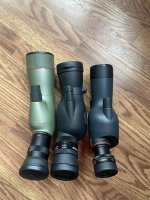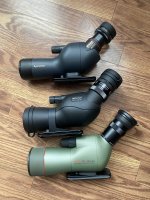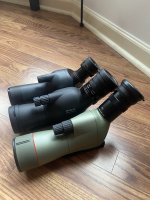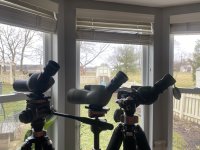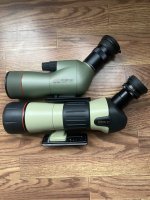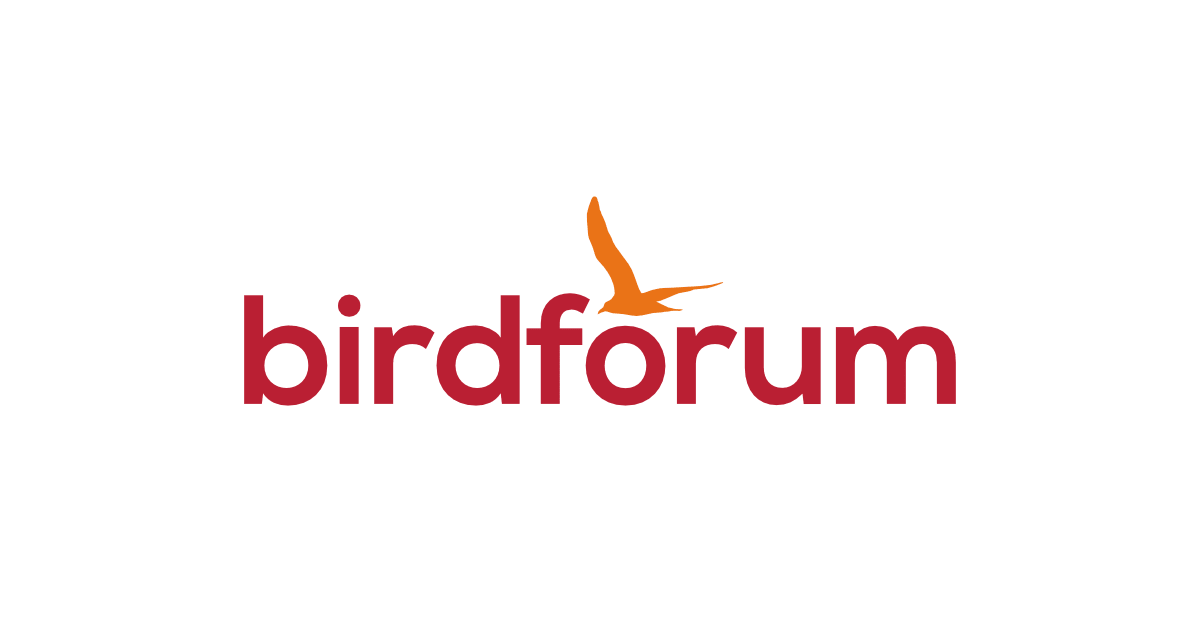Recently I picked up two Opticron MM4’s because of good sales I found. I acquired both the 50 and 60 MM4 and the SDLv3 and HDF T eyepieces and compared them to my Nikon ED 50 with MCII (13-40) eyepiece and my Nikon ED III 60 with MCII (20-60) eyepiece. Both Opticron eyepieces are 12-36 on the 50mm and 15-45 on the 60mm.
Regarding the MM4 50 v. 60, the 60 is brighter in most conditions other than bright daylight. Significantly? Not 50mm v. 80mm significant, but noticeable.
When comparing either Opticron eyepieces on both of the MM4 scopes, neither eyepiece is noticeably different. To me they appear the exact same. They might appear different on larger aperture scopes (77 and up) but I’m not sure. I see no difference in any lighting conditions and cannot see the supposedly better edge resolution of the SDL eyepiece.
Optically the Nikon 50 ED v. MM4 50 ED is very close. But, I will say the MM4 is brighter. Not significantly so, but noticeably so. Resolving power is the same. The Opticron feels more robust but this comes with a slight weight penalty. The Nikon is not fragile feeling, but you do have a sense to be more careful with it.
When comparing the 60mm scopes I appreciate the higher magnification ability of the Nikon ED III 60 (20-60) vs the MM4 60 (15-45) but do notice the Opticron is again brighter than the Nikon (even when at the same magnification). The resolving power is equal when comparing at the same magnifications. They both feel quite robust, but the Nikon feels heavier. Not much heavier, but slightly so.
I don’t notice any loss in resolution between either Nikon (50 & 60) v. Opticron (50 & 60), but the brightness difference is real. Whether this is because of new (Opticron) v. old (Nikon) eyepiece designs/coatings used, I’m not sure.
At the end of the day the Nikons are still fantastic scopes as are the Opticrons. Both Opticrons have rotating collars which I personally prefer. The Nikon ED 50 (straight and angled don’t rotate) and with the Nikon ED III it depends. Straight does not rotate and angled does. I think the ability to rotate is less important in a straight scope than an angled, but that is my personal opinion. Out of all of these scopes the only ones with lens hoods that extend out are the Nikon ED III 60’s.
My personal preferences lean toward the higher magnifications of the Nikon ED III 60 and the ability to rotate of the Opticron MM4 50.
You cannot go wrong with any of these scopes and eyepieces.
Regarding the MM4 50 v. 60, the 60 is brighter in most conditions other than bright daylight. Significantly? Not 50mm v. 80mm significant, but noticeable.
When comparing either Opticron eyepieces on both of the MM4 scopes, neither eyepiece is noticeably different. To me they appear the exact same. They might appear different on larger aperture scopes (77 and up) but I’m not sure. I see no difference in any lighting conditions and cannot see the supposedly better edge resolution of the SDL eyepiece.
Optically the Nikon 50 ED v. MM4 50 ED is very close. But, I will say the MM4 is brighter. Not significantly so, but noticeably so. Resolving power is the same. The Opticron feels more robust but this comes with a slight weight penalty. The Nikon is not fragile feeling, but you do have a sense to be more careful with it.
When comparing the 60mm scopes I appreciate the higher magnification ability of the Nikon ED III 60 (20-60) vs the MM4 60 (15-45) but do notice the Opticron is again brighter than the Nikon (even when at the same magnification). The resolving power is equal when comparing at the same magnifications. They both feel quite robust, but the Nikon feels heavier. Not much heavier, but slightly so.
I don’t notice any loss in resolution between either Nikon (50 & 60) v. Opticron (50 & 60), but the brightness difference is real. Whether this is because of new (Opticron) v. old (Nikon) eyepiece designs/coatings used, I’m not sure.
At the end of the day the Nikons are still fantastic scopes as are the Opticrons. Both Opticrons have rotating collars which I personally prefer. The Nikon ED 50 (straight and angled don’t rotate) and with the Nikon ED III it depends. Straight does not rotate and angled does. I think the ability to rotate is less important in a straight scope than an angled, but that is my personal opinion. Out of all of these scopes the only ones with lens hoods that extend out are the Nikon ED III 60’s.
My personal preferences lean toward the higher magnifications of the Nikon ED III 60 and the ability to rotate of the Opticron MM4 50.
You cannot go wrong with any of these scopes and eyepieces.
Attachments
-
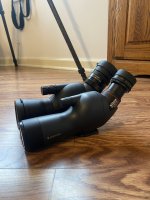 5BECE570-44A4-453A-8AFA-7390387C6031.jpeg1.6 MB · Views: 175
5BECE570-44A4-453A-8AFA-7390387C6031.jpeg1.6 MB · Views: 175 -
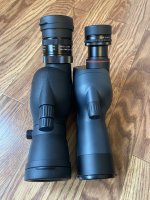 03FBCBD1-840B-44AB-A960-B274F34E09C5.jpeg2.1 MB · Views: 184
03FBCBD1-840B-44AB-A960-B274F34E09C5.jpeg2.1 MB · Views: 184 -
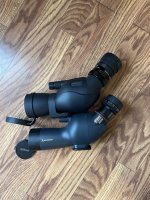 CA5C14F9-37B5-4563-B072-35C430028182.jpeg2.8 MB · Views: 196
CA5C14F9-37B5-4563-B072-35C430028182.jpeg2.8 MB · Views: 196 -
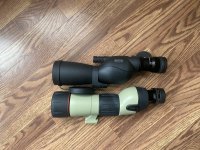 E3663B04-EDC0-45D2-BDF3-47A1881A4288.jpeg5 MB · Views: 188
E3663B04-EDC0-45D2-BDF3-47A1881A4288.jpeg5 MB · Views: 188 -
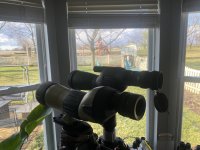 6B412FDC-47D8-46FE-B4DB-A9D45515CD43.jpeg2.5 MB · Views: 180
6B412FDC-47D8-46FE-B4DB-A9D45515CD43.jpeg2.5 MB · Views: 180





